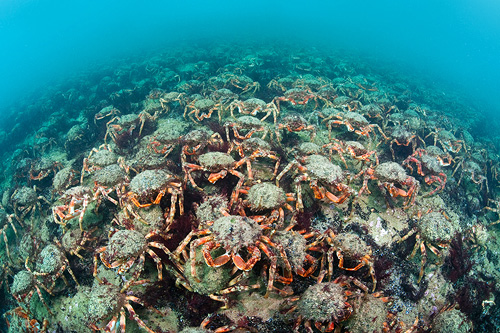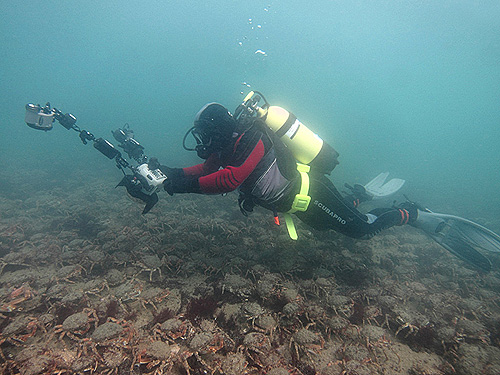Spider Crab aggregation

Alex Mustard describes the motivation and technique behind his image of a spider crab aggregation. (via DivePhotoGuide.)
The Idea:
Some photographs happen by chance, others after months of planning. This spider crab image has had a long gestation, which I guess makes it all the more satisfying now it is sitting on my hard drive.
I posted this picture on Facebook and have been shocked by the response. In 24 hours it picked up nearly 70 written comments. The day before I had posted a pair of dancing dolphins from my recent trip to the Bahamas, which got less than half that number. People clearly like the crabs, which is why I was asked to write this!
At the moment I am spending a lot of time shooting marine life in the UK. Why? It is a fair point. The UK’s murky, cold waters are not generally a place that people come to for diving. My motivation is that I am currently working on a project called 2020VISION as part of a team of nature photographers. The aim of the project is to show the importance of the UK’s wild places to the British people. And I have much of the responsibility for photography in the marine environment. So naturally I have been shooting some of the UK’s most exciting critters: basking sharks, seals, mating cuttlefish and seahorses.
But to address the core issues of the importance of healthy ecosystems, I also need to take on some less charismatic subjects. Particularly subjects that are best known as commercial fisheries. And still try and show them in a way that will capture the public’s hearts and minds. That was where the idea for the spider crabs came in. There is a strong commercial fishery for them in Europe. In Spain, for example, their meat is more valuable that lobster.
The Shot:
So after much planning the shot finally came together. The main technical challenge worth discussing is lighting the crabs well. Strobes are providing the foreground illumination, and must be balanced and fall off naturally into the ambient light. Positioning and aiming them correctly is crucial with such an unusual scene to light. The easy mistake is to position our strobes as we would for normal wide angle photography, with the strobes either side of the lens. This position will accentuate the fall-off of light, with the crabs at the front illuminated and those behind dark.
The solution is to push our up above the camera on long arms to create a pool of illumination in front of the camera by top-lighting the scene. This gives a more even lighting with a more gradual fall-off of light away from the camera. It is a technique we use for various subjects on my photo workshops, where it has picked up the nickname of “rabbit-ear strobes”. The second photo shows me reviewing my images, but shows how I had my strobes positioned for shooting the crabs.

Location: England, UK Equipment: Nikon D700 + Sigma 15mm fisheye lens. Subal housing, Zen 230 dome. 2x Inon Z240 strobes on 5.6 power. Ultralight arms. Settings: 1/160th @ f/14. ISO 640.